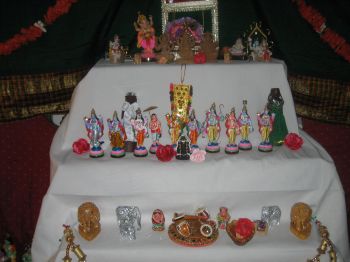What Durga Puja is to West Bengal, the Navarathri Bomma Golu is to Tamil Nadu and Karnataka. This custom of creating a special display of dolls during Navarathri has multi-layered significance.
Navarathri Golu is a lot of fun.
Golu, or ‘display’ is a tradition where people create an arrangement of steps in their homes, and use it to showcase their most beautiful collection of traditional dolls, statues and other decorative items. Usually, nine steps are arranged. However, 3, 5 or 7 stepped Golus are also common. The more dolls you wish to display, and the more space you have, the larger your Golu could be. Even temples and public halls display their own Golus in a much larger scale, with some life-size statues of deities and three-dimensional models.
Golu Unleashes Combined Creativity
It’s not just about arranging the statues, though. This is the time when creativity peaks in many households, as children and adults come together to make their Golu unique by building mini parks, zoos, cities and other models besides the main step-like display. Plans are made weeks ahead. This is a great occasion for families to spend quality time making crafts and building display items together.
Golu offers a feast for your senses
During Navarathri, women and girls are invited to each other’s homes to view the golu and accept small gifts. Women sing in praise of the Lord as they admire each other’s Golu displays. Lentils are cooked and constitute the main snack during Navarathri evenings. Houses are decorated with lamps and flour drawings (Kolam or Rangoli) on the floors.
The custom of Navarathri Golu serves many functions.
- It encourages socializing, especially among women and children who in olden days did not have the opportunity to mingle with people outside their families. Today, when busy lifestyles and work schedules leave us with little time to visit friends and neighbors, this custom provides an opportunity to meet people and unwind after a hectic day. The Navarathri season is a great time for community events and group celebrations.
- Women usually get together to sing or chant shlokas (holy verses) in praise of Goddesses Lakshmi, Saraswathi and Durga. Thus, many modern day women who don’t have the time or inclination to practice music or singing regularly, have the opportunity to learn new songs, refresh their memories and exercise their vocal chords, thus providing them with a creative outlet.
- The display itself is based on a structure – the lower steps allocated for inanimate objects, decorative items and animal statues. Statues of demi-gods and Gods are placed on the upper steps, the topmost step being reserved for the sacred Kalash or Kumbh (a silver or brass pot with a coconut placed at its mouth, representative of creation) and chief deities such as Ganesha, Shiva and others. This arrangement is both aesthetic and symbolic.
- Traditional Golu dolls are generally passed on from mother to daughter and so make wonderful family heirlooms. Preserving and passing these dolls on is a part of the south Indian culture and the custom of Navarathri Golu plays a role in keeping this rich culture and its elements such as dance, music and crafts alive.
Greeting friends and family, especially parents, grandparents and other elders to seek their blessings is an important part of Navarathri, just as any other Indian festival. This year, if you are unable to celebrate Navarathri with them for some reason, Free Ecards could be a great way to send your wishes instead. Choose from our selection of Free Durga Puja ecards and brighten their hearts this Navarathri. You could also use your own photos and create personalized photo cards if you prefer.
What is your favorite Navarthri custom?
 Have you sent out
Have you sent out 
